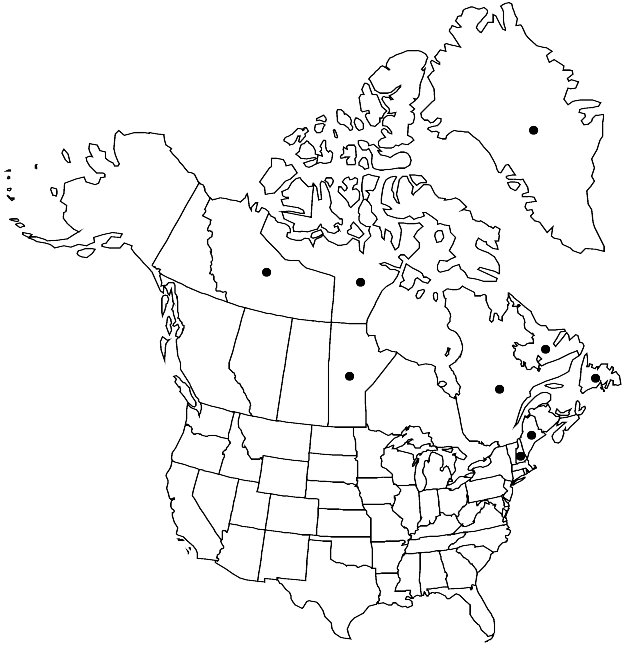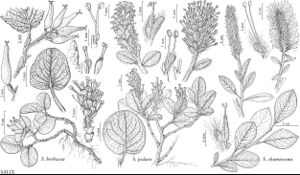Difference between revisions of "Salix herbacea"
Sp. Pl. 2: 1018. 1753.
FNA>Volume Importer |
FNA>Volume Importer |
(No difference)
| |
Revision as of 20:23, 24 September 2019
Plants 0.005–0.05 m, (dwarf), forming clonal mats by rhizomes. Stems erect; branches red-brown to violet, (sometimes weakly glaucous), glabrous; branchlets yellow-brown or red-brown, glabrous. Leaves: stipules absent; petiole (convex or flat to deeply grooved adaxially), 1.5–6(–7) mm; largest medial blade (2 pairs of secondary veins arising at or close to base, arcing) circular, subcircular or broadly elliptic, 6–21(–34) × 6–17(–31) mm, 0.9–1.4 times as long as wide, base usually subcordate or cordate, sometimes convex or rounded, margins flat, crenulate or crenate, apex rounded, convex, retuse, or toothed, abaxial surface (not glaucous), glabrous, adaxial slightly glossy to almost dull, glabrous; proximal blade margins crenulate; juvenile blade glabrous. Catkins: from subterminal buds; staminate 3–7.5 × 1.5–5 mm, flowering branchlet 0.3–2 mm; pistillate loosely flowered (2–11 flowers), stout to globose, 3.3–13 × 2–10 mm, flowering branchlet 0.8–3.5 mm; floral bract tawny, light rose, or brown, 0.5–1.5 mm, margins ciliate, apex rounded, retuse, or truncate, entire, abaxially glabrous. Staminate flowers: abaxial nectary 0.5–0.8 mm, adaxial nectary oblong or ovate, 0.6–1.1 mm, nectaries distinct, or connate and shallowly cup-shaped; filaments distinct, glabrous, or hairy on proximal 1/2; anthers shortly cylindrical or globose, 0.3–0.6 mm. Pistillate flowers: abaxial nectary (0–)0.2–0.3 mm, adaxial nectary narrowly oblong or oblong, 0.3–1.1 mm, longer or shorter than stipe, nectaries distinct or connate and shallowly cup-shaped; stipe 0.3–1.1 mm; ovary pyriform or ovoid, glabrous, beak abruptly tapering to styles; ovules 11–18 per ovary; styles connate to distinct, 0.2–0.4 mm; stigmas broadly cylindrical or 2 plump lobes, 0.08–0.24–0.32 mm. Capsules 2.2–7.5 mm. 2n = 38.
Phenology: Flowering late Jun-mid Aug.
Habitat: Snowbeds and places with good snow protection, well-drained riverbanks, sandy beaches, granite boulder ridges, steep bouldery slopes, or in marshes, usually on non-calcareous substrates, places exposed to sea-spray
Elevation: 0-1700 m
Distribution

Greenland, Man., Nfld. and Labr., N.W.T., Nunavut, Que., Maine, N.H., Europe (British Isles, Russia, Scandinavia, Spitzbergen), Atlantic Islands (Iceland).
Discussion
Salix herbacea is the only willow with an amphi-Atlantic distribution. Disjunct populations occur as far west as Great Bear and Great Slave lakes, Northwest Territories. Macrofossils show that, during the late-Wisconsinan period, it occurred in North America along the glacial margin between Minnesota (R. G. Baker et al. 1999) and Cambridge, Massachusetts (G. W. Argus and M. B. Davis 1962). D. J. Beerling (1998) provided a comprehensive review of its biology and ecology.
Hybrids:
Salix herbacea forms natural hybrids with S. arctica, S. argyrocarpa, S. fuscescens, and S. uva-ursi.
Salix herbacea × S. uva-ursi (S. ×peasei Fernald) was described from Mt. Washington, New Hampshire, but occurs also in northern Quebec (G. W. Argus, unpubl.). It is morphologically intermediate between the parents. Its distinctly crenulate, broadly obovate leaves are similar to those of S. herbacea, its catkins are smaller and have fewer flowers than those of S. uva-ursi but more flowers than those of S. herbacea, its leaves are sparsely glaucous abaxially, and it has stems stouter than those of S. uva-ursi.
Selected References
None.
